All published articles of this journal are available on ScienceDirect.
Building Materials of Neolithic Tombs in Alava, Northern Spain
Abstract
Fifty-two Neolithic tombs (dolmens) were grouped into megalithic stations that are mostly located on lithotecto from which the building rocks were removed. In six dolmens, there were no clues found to explain the presence of allochthonous stones, except perhaps in one of them, where rocks were selected to cause colour contrast. The morphology of the slabs, of chambers and corridors, showed no evidence of carving. The angularity of the tumulus blocks indicates that some were collected from the surface and others were manually fragmented. The identification of the construction materials in Neolithic dolmens with elemental geological features provides information on the building process, adding valorisation to the prehistoric monuments and enabling their reconstruction.
1. INTRODUCTION
Neolithic megaliths, built between 7000 and 3500 BP, are the oldest preserved buildings on Earth thanks to the use of stones as building materials. Further possible older structures built with other materials have not survived. The distribution of megalithic architecture is very wide, ranging from Korea to Atlantic Europe, where the highest densities of prehistoric buildings are situated.
Megalithism is characterized by the use of large stones and the absence of mortar. The three basic megalithic structures are menhirs, tumuli, and dolmens. The menhir, also known as Neolithic monolith, is the most basic structure, but its function is unknown. The tumulus or mound is an accumulation of rocks, usually with a circular pyramidal shape or conic and a sepulchral function. The dolmen is the most complex megalith and represents the first conserved structure that defines a volume. It consists of a tumulus under which there is a chamber, with or without an access corridor. Three types of dolmens have been distinguished on the Iberian Peninsula based on the type of wall that supports the large slabs of the cover: orthostats, imbricated slabs, and masonry [1]. The dolmen’s function was as a collective pantheon.
Alava is a province of about 3000 km2 in the Basque Country, northern Spain (Fig. 1). In 1831 the study of its megaliths began with the discovery of the Eguilaz dolmen, the first to be recognized as a prehistoric burial site in Spain [2]. Afterwards, two archaeological catalogues were published describing more than 170 Neolithic buildings [3, 4], 85 of which were considered to be dolmens. Of these 85 catalogued dolmens, 26 are not included in the present study because they could not be located or have been destroyed, or because they do not occur in Alava. Another 7 presumed dolmens are now considered tumuli. In short, in this study a total of 52 dolmens are taken into account (Table 1).
The average dimensions of the Alavesian dolmens are 2.16 m in height and 17.5 m in diameter, ranging between 0.5 and 4 m in height and 5 and 64 m in diameter. The dolmens are located between 511 m and 1141 m above sea level and occur mainly on horizontal surfaces and never on summits or hills. Except for three dolmens with orthostatic walls, all the others have walls made of imbricated slabs. The number of burials in each dolmen can be very high, and they were used for long periods. For example, in Los Llanos dolmen (Fig. 1), up to 100 individuals have been detected, ranging in burial ages from 4015 ± 215 BC to 2675 ± 225 BC [5], which represents 1350 years of use. According to published dates, the Alavesian dolmens were used between 6000 BP and 3000 BP [6].
| NAME | Megalithic Station | X | Y | Z | Substratum Lithology | Slabs Lithology | Displacement | Blocks Lithology | Displacement |
|---|---|---|---|---|---|---|---|---|---|
| Alarán | Gorbea | 522832 | 4761475 | 944 | Albian sandy clays | ? | ? | Albian sandstones | 200 |
| Gambidea | Gorbea | 511166 | 4765710 | 907 | Albian sandy clays | ? | ? | Albian sandstones | |
| Ollargan | Aramayona | 530039 | 4769872 | 797 | Albian sandy clays | ? | ? | Albian sandstones | |
| Aguiñaran | Elguea-Urquilla-Alzania | 560481 | 4749471 | 972 | Albian sandy clays | Albian sandstones | > 250 | Albian sandstones | 0 |
| Artaso | Elguea-Urquilla-Alzania | 548176 | 4756474 | 1038 | Albian sandy clays | Albian sandstones | < 500 | Albian sandstones | < 500 |
| Larrasoil | Elguea-Urquilla-Alzania | 554891 | 4751429 | 946 | Albian sandy clays | Albian sandstones | 0 | Albian sandstones | 0 |
| Urkitzako Lepoa | Elguea-Urquilla-Alzania | 551075 | 4755259 | 1143 | Albian sandy clays | Albian sandstones | 0 - 100 | Albian sandstones | 0 |
| Alto de Lejazar | Guibijo | 503253 | 4754076 | 844 | Coniacian limestones | Coniacian limestones | 0 | Coniacian limestones | 0 |
| Ataguren | Guibijo | 505608 | 4751420 | 803 | Coniacian limestones | Coniacian limestones | 0 | Coniacian limestones | 0 |
| Lejazar meridional | Guibijo | 503327 | 4753774 | 843 | Coniacian limestones | Coniacian limestones | 0 | Coniacian limestones | 0 |
| Los Cotorricos I | Guibijo | 503442 | 4750178 | 873 | Coniacian limestones | Coniacian limestones | < 500 | ? | ? |
| SB-32 | Badaya | 511559 | 4750395 | 816 | Coniacian limestones | Coniacian limestones | 0 | Coniacian limestones | 0 |
| Arrizacen | Encía-Iturrieta | 558979 | 4744050 | 1052 | Paleocene sandstones | Paleocene limestones | > 150 | Miocene calcareous conglom. | 0 |
| Gaztelamendi | Encía-Iturrieta | 552912 | 4738999 | 1046 | Paleocene marl limestones | Paleocene limestones | 0 | Paleocene limestones | 0 |
| Gaztalamendi II | Encía-Iturrieta | 552783 | 4738888 | 1032 | Paleocene marl limestones | Paleocene limestones | 0 | Paleocene limestones | 0 |
| Igurita | Encía-Iturrieta | 559581 | 4741575 | 1022 | Paleocene limestones | Paleocene limestones | 0 | Paleocene limestones | 0 |
| Itaida N | Encía-Iturrieta | 559161 | 4740165 | 967 | Paleocene limestones | Paleocene limestones | 0 | Pal. limestones and Miocene conglom. | 0 y > 150 |
| Itaida S | Encía-Iturrieta | 558640 | 4739593 | 1009 | Miocene calcareous conglom. | Paleocene limestones | > 150 | Miocene calcareous conglom. | 0 |
| Larragorri | Encía-Iturrieta | 554716 | 4738839 | 1025 | Paleocene limestones | Paleocene limestones | 0 | Paleocene limestones | 0 |
| Legaire N | Encía-Iturrieta | 559312 | 4743245 | 1013 | Dissolution clays | Paleocene limestones | > 500 | Paleocene limestones and clays? | ? |
| Legaire S | Encía-Iturrieta | 559103 | 4742943 | 1009 | Dissolution clays | Paleocene limestones | > 250 | Paleocene limestones and clays? | ? |
| Morube | Encía-Iturrieta | 558333 | 4737333 | 1077 | Paleocene limestones | Paleocene limestones | 0 | Paleocene limestones | 0 |
| Portillo de Kortagaina | Encía-Iturrieta | 554953 | 4736394 | 1070 | Paleocene limestones | Paleocene limestones | 0 | Paleocene limestones | 0 |
| Puerto de Alangua I | Encía-Iturrieta | 552797 | 4739356 | 1069 | Paleocene limestones | Paleocene limestones | 0 | Paleocene limestones | 0 |
| Puerto de Alangua II | Encía-Iturrieta | 552875 | 4739254 | 1070 | Paleocene limestones | Paleocene limestones | 0 | Paleocene limestones | 0 |
| San Juan | Encía-Iturrieta | 549268 | 4739336 | 1023 | Paleocene limestones | Paleocene limestones | 0 | Paleocene limestones | 0 |
| Santa Teodosia I | Encía-Iturrieta | 552610 | 4734949 | 1040 | Paleocene limestones | Paleocene limestones | 0 | Paleocene limestones | 0 |
| Santa Teodosia II | Encía-Iturrieta | 552547 | 4735516 | 1044 | Paleocene limestones | Paleocene limestones | 0 | Paleocene limestones | 0 |
| Santa Teodosia III | Encía-Iturrieta | 552518 | 4735247 | 1036 | Paleocene limestones | Paleocene limestones | 0 | Paleocene limestones | 0 |
| Las Campas de Oletar | Ayala | 490962 | 4766408 | 554 | Coniacian marls | Conianian marl limestones | 250 ? | Conianian marl limestones | 250 ? |
| Las Campas E | Ayala | 488554 | 4766371 | 537 | Coniacian marls | ? | ? | Conianian marl limestones | 250 ? |
| Las Campas W | Ayala | 488506 | 4766351 | 534 | Coniacian marls | Conianian marl limestones | 250 ? | Conianian marl limestones | 250 ? |
| Gurpide N | Cuartango | 508513 | 4750732 | 579 | Coniacian marls | Coniacian limestones | 500 - 1000 | Coniacian limestones | < 100 |
| Gurpide S | Cuartango | 508577 | 4750682 | 576 | Coniacian marls | Coniacian limestones | 500 - 1000 | Coniacian limestones | < 100 |
| San Sebastian N | Cuartango | 508498 | 4751139 | 584 | Coniacian marls | Coniacian limestones | 500 - 1000 | Coniacian limestones and boulders | > 250 |
| San Sebastian S | Cuartango | 508384 | 4750934 | 587 | Coniacian marls | Coniacian limestones | 500 - 1000 | Coniacian limestones | < 100 |
| Laurimendi | Zuya | 515555 | 4754443 | 646 | U. Cretaceous marl limestones | U. Cretaceous marl limestones | > 500 | U. Cretaceous marl limestones | > 100 |
| La Llana de Vitoriano | Zuya | 514863 | 4755069 | 615 | Keuper clays | U. Cretaceous marl limestones | > 500 | U. Cretaceous marl limestones | > 100 |
| Eguilaz | La Llanada | 554285 | 4745843 | 606 | U. Cretaceous marls | U. Cr. limestones and Alb. sandston | > 3000 - 5000 | U. Cretaceous marls | 0 |
| Escalmendi | La Llanada | 529535 | 4747541 | 509 | U. Cretaceous marls | ? | ? | U. Cretaceous marls | 0 |
| Kurtzebide | La Llanada | 520451 | 4753850 | 570 | U. Cretaceous marls | U. Cretaceous marl limestones | 0 | ? | ? |
| Sorginetxe | La Llanada | 550818 | 4742076 | 622 | U. Cretaceous marls | Paleocene limestones | > 3000 | ? | ? |
| La Lastra | Bayas | 502246 | 4732021 | 532 | Miocene sandy clays | Miocene sandstones | > 100 | Miocene sandstones | > 100 |
| La Mina | Bayas | 502075 | 4732800 | 582 | Miocene sandy clays | Miocene sandstones | > 100 | Miocene sandstones | > 100 |
| Alto de la Huesera | Rioja Alavesa | 535613 | 4713104 | 610 | Miocene sandy clays | Miocene sandstones | > 100 | Mioc. sandstones and U. Cr. limestones | < 100 y > 3000 |
| El Encinal | Rioja Alavesa | 538337 | 4713354 | 595 | Miocene sandy clays | Miocene sandstones | > 200 | Miocene sandstones | > 200 |
| El Montecillo | Rioja Alavesa | 527478 | 4711360 | 511 | Miocene sandstones and clays | Miocene sandstones | 0 | Mioc. sandstones and U. Cr. limestones | 0 y 4500 |
| El Sotillo | Rioja Alavesa | 531031 | 4713544 | 613 | Miocene sandy clays | Miocene sandstones | > 200 | Mioc. sandstones and U. Cr. limestones | 0 y > 2000 |
| La Chabola de la Hechicera | Rioja Alavesa | 536642 | 4712896 | 595 | Miocene sandy clays | Miocene sandstones | > 150 | Miocene sandstones | > 150 |
| Layaza | Rioja Alavesa | 528479 | 4714228 | 670 | Miocene sandy clays | Miocene sandstones | > 200 | Mioc. sandstones and U. Cr. limestones | > 200 y > 1000 |
| Los Llanos | Rioja Alavesa | 538371 | 4715807 | 681 | Miocene sandstones and clays | Miocene sandstones | > 250 | Miocene sandstones | > 250 |
| San Martin | Rioja Alavesa | 533312 | 4712247 | 570 | Miocene sandy clays | Miocene sandstones | > 250 | Mioc. sandstones and U. Cr. limestones | > 250 y > 2500 |
The rock types used in the Alavesian historical monuments have been determined in the previous works [7-10] and they mainly consist in Palaeocene and Upper Cretaceous limestones and, Miocene and Albian sandstones. In this study, the rocks used in Neolithic dolmens are identified for the first time, with special attention to the lithology, size, and morphology of the materials, and the implications of these characteristics.
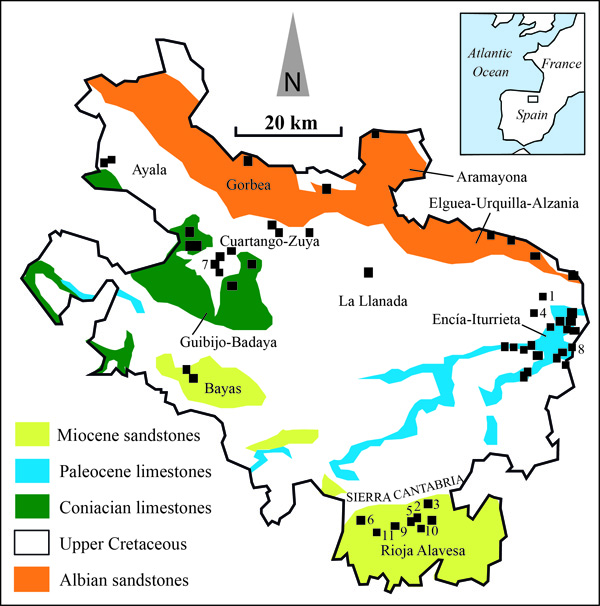
2. BUILDING UNITS AND SIZES OF MATERIALS
The rocks used in each building unit differ markedly in size (Fig. 2a). A conventional particle-size classification has been used to describe the tumuli, which mainly corresponds to the ‘block’ size. In describing the chambers and corridors, the slabs are referred with their corresponding measures. Each size reflects different functions in the construction: the blocks and smaller elements were used to construct the tumulus while the slabs defined the void volume within the dolmen. In addition, the difference in size implied a different handling. In fact, tumulus blocks were manageable by a single operator, while the chambers and corridors slabs required several workers, animals, or mechanical devices currently unknown.
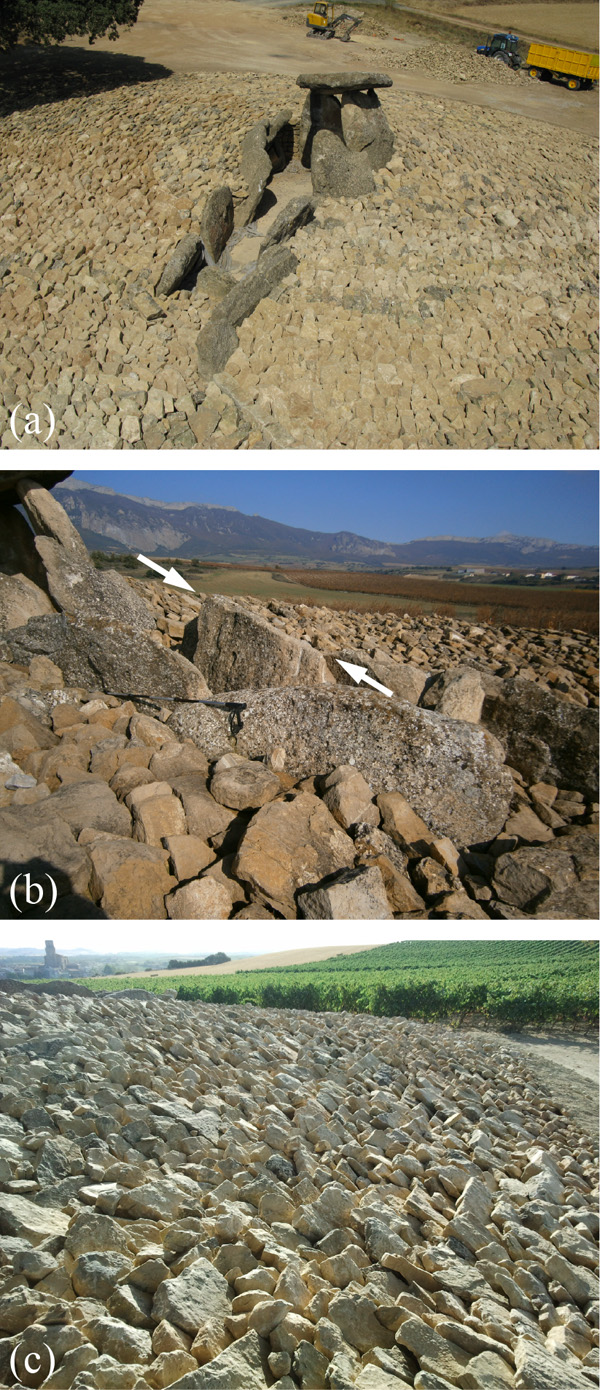
3. METHODOLOGY
The rocks that constitute the monumental buildings constructed in Alava in all the historical periods until 1900 have been identified, including those of the Cathedral of Santa Maria [11] and the 487 churches in the diocese of Vitoria [7]. Spatio-temporal associations between the lithologies and the artistic periods have been defined [8] and interesting Romanesque lithological combinations have been described [9]. There are several articles on the building materials used in prehistoric times [12-14], and one specifically addresses the geological features of the Alavesian menhirs [15]. All these researches have contributed to the present study.
In Alava, the main lithotypes or rocks that were used in the constructions are Albian and Miocene sandstones, and Coniacian and Paleocene limestones (Fig. 1). Their petrographic, mechanical, and durability characteristics have been described previously [11]. These lithotypes are distributed in the lithotectos or geological bodies represented on geological maps. The identification of lithotypes and lithotecto distributions has enabled the discovery of many kinds of ancient quarries [16].
In this study, the dolmens were localized using published catalogues [3, 4]. Later, the materials were identified, their sizes were measured and their morphologies determined. Rock identification and allocation to a lithotype were accomplished by visual inspection. After that, the related lithotecto was localized on the geological map. If the dolmen was not over lithotecto, the minimum distance between the Neolithic monument and the nearest corresponding outcrop was measured on map.
The measurements of the chamber and corridor slabs were made directly. The particle sizes of the blocks of the tumuli were estimated by photographs, in which the diameters of the blocks were measured and the average values calculated.
The morphologies of the rocks were defined by three parameters: shape, sphericity, and roundness. The ‘shape’ was determined from the axial relationships of height, width, and thickness, defining four types: discoid, spherical, tabular, and elongate [17]. The ‘sphericity’ is the degree of approximation to a sphere. The shape and sphericity are related to the original block extracted from the quarry. The ‘roundness’ refers to the curvature or sharpness of edges and corners. A Powers graph [18] was employed to determine the sphericity and roundness. Roundness, or its opposite term, ‘angularity’, indicates the degree of erosion and is important to know the origins of rocks. If the edges are rounded, it follows that the rock surface has been exposed for a long time. Conversely, if the roundness index for a given rock type is very low, it has originated from mechanical fracturing. In this study, rounded blocks were interpreted as having been collected directly from the ground surface and angular blocks as having been obtained using manual fragmentation. This approach has been validated by comparing rocks collected from the surface and others extracted mechanically [19].
4. MEGALITHIC STATIONS AND LITHOTECTOS
The Alavesian megalithism is grouped into stations based on geographic units. In turn, these stations correspond to geomorphological units that are defined by the lithological substrate. Therefore, the megalithic stations rest on litho-morphological units characterized by a common lithology, so when a megalithic station is cited, it indirectly indicates the lithology of the substrate. In other words, the distribution of megaliths is related to the lithology. Therefore, the megalithic stations differentiated in the published catalogues [3, 4] overlap the lithotectos previously delimited with geological mapping (Fig. 1). Exceptionally, two of the fifty-two studied dolmens lie on substrates with no building material around.
5. CHAMBER AND CORRIDOR SLABS
5.1. Lithology
Generally, the rocks used in a dolmen belong to the megalithic station itself and were transported within the lithotecto. There are two unique dolmens in La Llanada (Fig. 1): Sorginetxe (Fig. 3) and Eguilaz (Fig. 4), where no rocks suitable for megalithic slabs are available, requiring the building material to be transported. Both dolmens rest on a substrate of Upper Cretaceous marl-limestone.

In the Sorginetxe dolmen, the chamber is built of Paleocene limestone. The nearest outcrop of this rock is 3 km away, so this is the minimum distance to be covered to transport the slabs. In the Eguilaz dolmen, all of the slabs are Paleocene limestone, with the only exception of Albian sandstone. Ten limestone slabs, weighing 1000-11000 kg, were transported at least 3 km, and the sandstone block of 4500 kg was transported for more than 5 km. This observation was made by Barandiaran [20] based on the lithology and was corroborated petrographically by Vegas et al. [21]. It is unknown why a slab of Albian sandstone was transported at least 5 km if there were Paleocene limestones available at a short distance of 3 km.
5.2. Morphology
The morphology of the slabs was determined by the type of source rock. Because the Alava area is dominated by sedimentary rock, the dimensions of the slabs are related to the layer of provenance. The thickness of the slab corresponds to the thickness of the source layer, and the other two dimensions, height and width, are limited by the joint system [13]. In general, the predominant shape of the slabs is tabular.
After several thousand years, part of the dolmen structure was exposed to sub-aerial conditions and the slabs eroded. So, in general, the slabs were very rounded. However, some slabs show sharp corners, as evidence of mechanical fracturing. Two kinds of fractures have been differentiated, one which is related to the structure of the dolmen and the other related to external source with or without intentionality.
Structural fractures arise from overloading. For example, the Sorginetxe dolmen contains a broken slab that failed along joint surfaces (Fig. 3). The fracture surface has rounded edges, indicating that it is an old fracture, but its age cannot be determined. Another example of a structural fracture can be seen in the dolmen of Alto de la Huesera (Fig. 5a). A force analysis suggests that the fragmented slab suffered overload caused by the asymmetry of the structure [14]. The slab, instead of rotating, was fractured, forming a window in the chamber. The edges of the fractured surface are sub-rounded, so it is an old fracture.
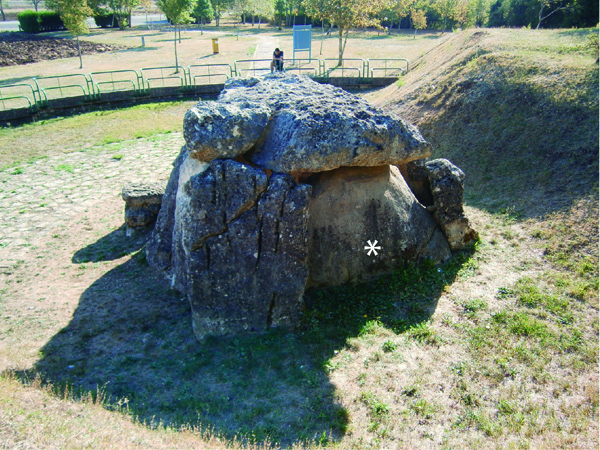
The fractures on the tops of the slabs in the walls of some chambers and corridors are more-or-less conchoidal, with sharp edges. At La Chabola de la Hechicera (Fig. 2b), these surfaces are explained as having been carved to level the covers or capstones of the corridor [22]. In the Layaza dolmen, the tops of almost all the chamber slabs appear to have been retouched (Fig. 6). In both cases, it is possible that the rocks were originally carved on their top edges, but have also been broken during more recent agricultural activities. In either case, the fractured surfaces are angular, indicating that they are not very old.
The ages of the dolmens must be considered when interpreting the origins of the fractured surfaces of the slabs. Most of them were built before the use of metal tools, so the only tools used were stone maces, most likely ophites [23]. No marks made by metallic tools have been observed. In short, it is difficult to prove that the slabs of the chambers and corridors have been retouched or intentionally carved. Furthermore, although the fracture surfaces are recognizable, it is difficult to determine their ages, and they may originate from a post-Neolithic period.
6. TUMULUS BLOCKS
6.1. Lithology
The rocks of the tumuli are almost always from the same megalithic station, suggesting that the closest building materials were chosen. However, there are some exceptions that require further investigations.
At the Cuartango megalithic station, most tumular blocks are angular fragments obtained by manual fracturation of the local Coniacian limestone, but in the dolmen of San Sebastian N (Fig. 1), there are some alluvial sandstone boulders, transported by at least 250 m. A cause to explain the presence of these boulders is that the effort required to fracture and place the underlying Coniacian limestone was similar to that required to collect, transport, and place the superficial alluvial boulders.
A similar case is the dolmen of Itaida N in Sierra de Entzia (Fig. 1). Part of the tumulus is composed of angular fragments obtained by manual fracturation of the local Paleocene limestone, whereas other blocks are boulders of a Miocene conglomerate that occurs 150 m away. It is likely that the effort required to obtain and transport the Paleocene limestone fragments was similar to that required for the surface collection and transport of the Miocene boulders, thereby explaining their presence. Therefore, in these tumuli, the selected rocks are consistent with the principle of minimal effort.
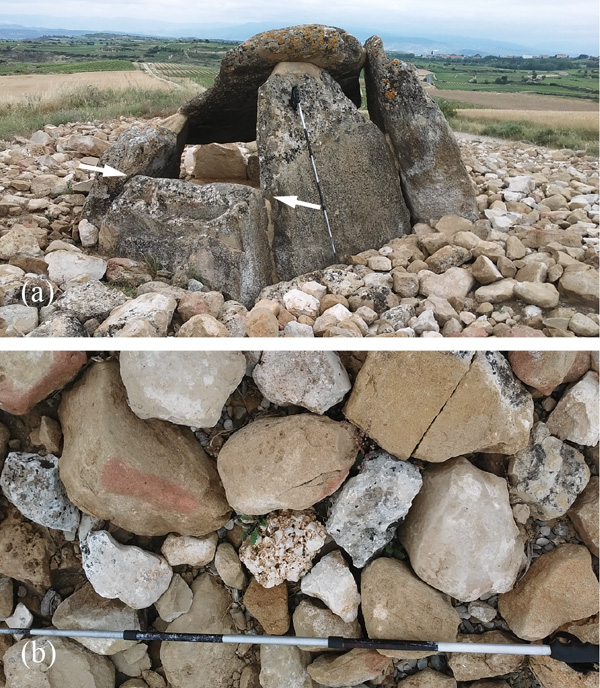
In Rioja Alavesa, the dolmens of Alto de la Huesera, Layaza, El Sotillo, San Martin, and El Montecillo Fig. (1) are built mainly of the local Miocene sandstone. However, in the tumuli, there are also Upper Cretaceous limestone blocks from the colluviums of the Sierra Cantabria (Fig. 1). The volumetric proportion of limestone ranges from about 30% in the Alto de la Huesera to 1% or less in El Montecillo. Although the building material for these dolmens was available close by, the limestone blocks were moved by at least the following distances: Layaza, 1 km; El Sotillo, 2 km; San Martin, 2.5 km; Alto de la Huesera, 3 km; and El Montecillo, 4.5 km. In Alto de la Huesera (Fig. 5b), the strong presence (up to 30%) of white limestone could be explained as an intention to create a strong colour contrast between the tumulus and the ochre tones of the surrounding countryside. However, in other dolmens, the anomalous presence of white limestone is difficult to explain. Therefore, if the principle of minimal effort is not applicable, it seems that some meaning or value was attributed to the building materials used that we cannot interpret today.
6.2. Size
Most tumuli are built with centimetre-to-decimetre-sized blocks, which could be handled by a single operator. In six tumuli, the diameters of the blocks are centimetric and remember soil levels. These tumuli are always located on cayuelas, marl limestones, or marls of the Upper Cretaceous. The cayuelas usually contains a small fraction of swelling clay that changes in volume with humidity, resulting in rapid weathering [7]. If cayuelas from the Upper Cretaceous was used in the tumuli of these dolmens, it is likely that the present soil-like appearance corresponds to the weathering of the original rock.
6.3. Angularity
If a boulder is hit and broken into two fragments, the fracture surface shows a sharp edge, unlike the original outer surface, which is rounded. Based on this observation, the angularity of the blocks of the tumuli is considered an important parameter. The angular blocks were produced by intentional mechanical fracturing, which implies an extraction quarry, whereas the eroded rounded blocks were collected from the ground surface.
In the La Chabola de la Hechicera dolmen (Fig. 2c), the strong angularity of the Miocene sandstone blocks has been interpreted as reflecting an origin by quarrying [19]. In the neighbouring dolmen of Alto de la Huesera, tumulus blocks with the same lithology are highly rounded (Fig. 5b), inducing to suppose that they have been collected from the surface. Among the fifty-two dolmens visited, two-thirds of the tumulus blocks were collected from the surface and one-third was obtained mechanically by manual fracturation. It is assumed that for a given lithology, the blocks will be collected on the surface or by fracturing according to the principle of minimum effort.
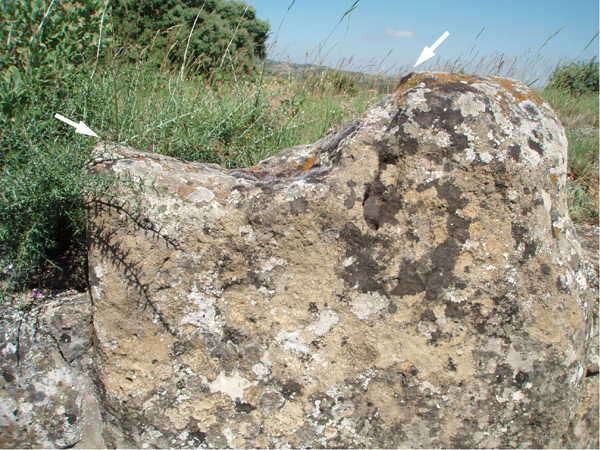
DISCUSSION
Local natural stones were used in most Alavesian dolmens, usually from the megalithic station itself. In the two dolmens located in an area lacking available building materials, the rocks were transported to the site. In these cases, the chosen location took precedence over the availability of building materials. The criteria used in choosing these sites are unknown.
In terms of the types of rocks chosen for the slabs, the only anomaly is observed in the Eguilaz dolmen [20, 21]. It contains a slab of Albian sandstone, moved at least 5 km, whereas the remaining Paleocene limestone slabs were moved from the nearest source, 3 km away. Why that slab of sandstone was selected, despite involving more arduous transport, is unknown.
The blocks of the tumuli were also often locally sourced, except in five dolmens in Rioja Alavesa, which were constructed with limestone blocks transported from 1 to 4.5 km away. Very little allochthonous limestone was used, except in the tomb of Alto de la Huesera, where it accounts for 30% of the building material. This high percentage of white limestone produces a strong colour contrast with the surroundings, which could justify its transport for 3 km. The presence of allochthonous rocks is difficult to explain, and their use may be motivated by factors not understood today.
The morphology of the Neolithic building materials also provides information about the selection of the rocks and their handling. In general, erosion tends to smooth the shapes of rocks. This can obscure the origins of some fracture planes, and neither their function nor age can be determined. In general, it is assumed that the slabs of chambers and corridors were not carved. However, the angularity of tumulus blocks means that rocks generated by mechanical fragmentation can be distinguished from those collected from the surface.
The choice of rocks used in Alavesian historical buildings is governed by the principle of minimal effort [8], although in other areas has not been verified [24-26]. This principle has been confirmed for the Alavesian Neolithic dolmens, except for the singular choice of a slab in the Eguilaz dolmen and the allochthonous blocks used in the dolmens of Rioja Alavesa. In these cases, the criteria used in their selection, as in the choice of sites, are not yet understood.
Dolmens are the oldest architectural structures thanks to the used construction materials. The analysis of Neolithic building materials provides information on building processes, from the collection or manufacture of the material to its placement on the monument. Our knowledge of the morphology and origin of the rocks used in Neolithic times has also been applied to reconstruct the dolmens of La Chabola de la Hechicera [19] and Alto de la Huesera [14]. Understanding the building materials also adds valorisation to the monuments, promoting their knowledge.
CONCLUSION
This study analysed the building materials of fifty-two Neolithic dolmens in Alava. These were differentiated according to their functions as either the slabs of chambers and corridors or the blocks of tumuli. Slabs delimit the interior volumes and blocks fill the external structures of the dolmens. The slabs were large and their manipulation required the cooperation of several operators, whereas the blocks were transportable by a single person.
The dolmens were distributed according to megalithic stations that correspond to litho-morphological units. These units were related, in turn, to the lithotectos already recognized in historical buildings [7, 8]. In general, all the constructions were built with the lithotype that was characteristic of the megalithic station, confirming that the acquisition of the material followed the principle of minimal effort. If no building material was available on site, it was transported from nearby locations. The few exceptions, in which allochthonous rocks that required an additional transport were selected, cannot be explained.
The analysis of Neolithic building materials allows reconstructing the processes used in the past, and in addition, it facilitates the restoration and conservation of these structures as well as their knowledge.
CONFLICT OF INTREST
The author confirms that this article content has no conflict of interest.
ACKNOWLEDGEMENTS
Declare none.


